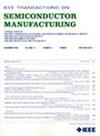用于减少半导体制造过程中副产品颗粒的等离子体预处理系统
IF 2.3
3区 工程技术
Q2 ENGINEERING, ELECTRICAL & ELECTRONIC
引用次数: 0
摘要
四氯化钛 (TiCl4) 是众所周知的钛 (Ti) 来源,用于在半导体互连工艺中形成氮化钛 (TiN) 阻挡层材料;然而,副产品与空气中的分子发生反应,可能会因副产品粉末堆积而导致泵意外跳闸和设备故障。等离子洗涤器用于分解副产品,但在此过程中和之后会产生氯化氢 (HCl) 和氮氧化物。当热源的温度和应用功率发生变化时,工艺机理也会发生变化。本文研究了等离子体预处理系统(PPS)中反应器温度和热源功率对 TiCl4 分解能力的影响。我们研究了温度和热源功率的影响,以便通过同步方法了解气态物质的组成和分解与化学反应的反应机理。我们利用计算流体动力学(CFD)和化学动力学模拟对系统进行了分析,以研究系统机理的变化。随后,我们得出了反应器温度、热源功率、物种组成和分解以及化学反应机制之间的相关性结果。本文章由计算机程序翻译,如有差异,请以英文原文为准。
Plasma Pretreatment System for the Reduction of By-Product Particles in Semiconductor Manufacturing
Titanium tetrachloride (TiCl4) is a well-known source of titanium (Ti) for the formation of titanium nitride (TiN) barrier material in the semiconductor interconnection process; however, the reaction of by-products with airborne molecules can cause unexpected pump trips and equipment breakdown from the by-product powder build-up. Plasma scrubbers are used to decompose by-products, but hydrogen chloride (HCl) and nitrogen oxides are produced during and after the process. The process mechanisms change when the temperature and applied power of the heat source change. In this paper, we study the influence of the reactor temperature and applied power to the heat source on the decomposition capacity of TiCl4 in a plasma pretreatment system (PPS). We examine the effect of the temperature and heat source power to understand the reaction mechanisms for the composition and decomposition of gaseous species with chemical reactions through simultaneous methods. We analyzed the system with computational fluid dynamics (CFD) and chemical kinetic simulation to investigate the changes of the system mechanism. Subsequently, we achieved results for the correlation between the temperature of the reactor, power applied to the heat source, composition and decomposition of species, and chemical reaction mechanisms.
求助全文
通过发布文献求助,成功后即可免费获取论文全文。
去求助
来源期刊

IEEE Transactions on Semiconductor Manufacturing
工程技术-工程:电子与电气
CiteScore
5.20
自引率
11.10%
发文量
101
审稿时长
3.3 months
期刊介绍:
The IEEE Transactions on Semiconductor Manufacturing addresses the challenging problems of manufacturing complex microelectronic components, especially very large scale integrated circuits (VLSI). Manufacturing these products requires precision micropatterning, precise control of materials properties, ultraclean work environments, and complex interactions of chemical, physical, electrical and mechanical processes.
 求助内容:
求助内容: 应助结果提醒方式:
应助结果提醒方式:


